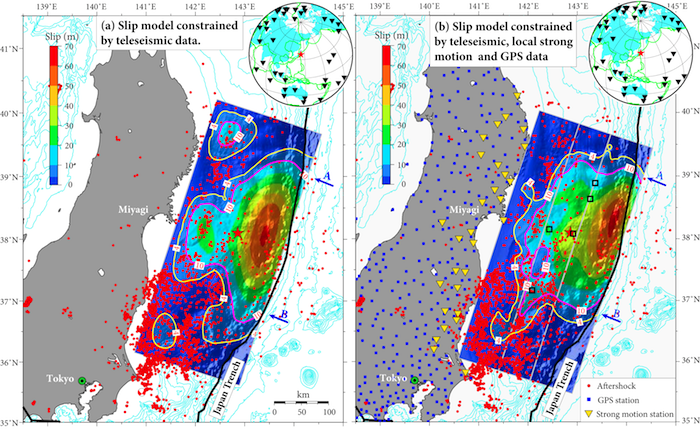2012 IRIS Workshop
Quality of Earthquake Source Models Constrained by Teleseismic Waves: Using the 2011 M9 Tohoku-Oki Earthquake as an Example
Guangfu Shao: Department of Earth Science, University of California Santa Barbara; Chen Ji: Department of Earth Science, University of California Santa Barbara; Ralph Archuleta: Department of Earth Sc
Comparison of slip distributions of the teleseismic slip model (a) and the joint inversion model (b) for the 2011 Tohoku-Oki earthquake. The quick teleseismic model has a similar major slip patch as the update model. Red star and dots indicate the earthquake epicenter and the JMA aftershocks (M>3) within 1 week. Upper insert panel shows selected teleseismic stations (triangles). Yellow triangles denote strong motion stations. Blue and open squares indicate inland and ocean bottom GPS stations.

Full-resolution graphics file in original format: 0115.jpg
Slip distributions of recent global large (M>7) earthquakes have been routinely studied using broadband body waves and long period surface waves recorded at distant stations. The 2011 M9 Tohoku-Oki earthquake, which was well recorded not only by global seismic stations but also by local strong motion stations and inland and offshore GPS sites, provides a unique opportunity to evaluate the quality of teleseismic solutions for shallow subduction earthquakes. We compared our quick slip model constrained by teleseismic data only with our update slip model constrained by jointly inverting teleseismic waveforms, local strong motion data, along with the inland and offshore GPS vectors. Two solutions are very consistent in terms of total seismic moment, rupture duration, peak slip amplitude, and along-strike and down-dip extensions of the major slip patch. The major features of rupture spatiotemporal evolution inferred from the teleseismic analysis are also reaffirmed by the local observations.
Acknoweldgements: We thank IRIS data center for providing broadband waveforms, KiK-net for providing strong motion data, ARIA team at JPL and Caltech for sharing the continuous GPS data, and Japan Oceanographic Data Center for sharing the bathymetry data (J-EGG500). This work was supported by NSF grant EAR-0911769, USGS Award G09AP00023, and the Southern California Earthquake Center, which is funded by NSF Cooperative Agreement EAR-0109624 and USGS Cooperative Agreement 02HQAG0008.
For further reading: Shao, G., X. Li, C. Ji, and T. Maeda (2011), Focal mechanism and slip history of 2011 Mw 9.1 off the Pacific coast of Tohoku earthquake, constrained with teleseismic body and surface waves, Earth Planets Space, 63(7), 559–564. Shao, G. and C. Ji(2011), Rupture characterizations of the 2011 Mw 9.1 off the Pacific coast of Tohoku earthquake and its March 9th Mw 7.4 foreshock constrained by an unprecedented dataset for subduction earthquakes, Eos Trans. AGU, 91, Fall Meet. Suppl., Abstract U34A-03.
Keywords: 2011_tohoku-oki_earthquake, finite_fault_inversion, teleseismic_waves
